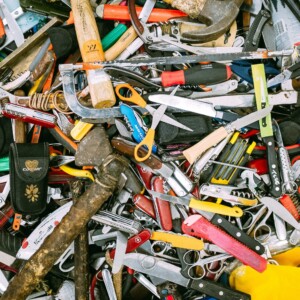
It’s understood that there can be great resistance to sorting through possessions when there is a clutter issue. The sheer volume and disorganization of items can be enough to make someone not want to deal with it at all.
Often, professional organizers will approach the mess with the suggestion that their client place their belongings into piles of things they can part with, things they definitely want to keep and things they are uncertain about. Frequently, the person does not want to get rid of anything they have been hanging onto for years.
I would like to suggest another initial approach, which may seem less threatening, and in some ways more therapeutic, in that it can really make someone deal with their clutter in a more “black and white” format. This suggestion is to simply make lists of what one has, going through all the rooms, drawers and closets, without the emotional burden of having to immediately decide what to keep, sell, give away or throw away.
I liken this approach to dieting and writing down everything you eat. It’s easy for a person who is restricting their food intake to feel like they are “starving.” But when they write down what they have eaten so far in the day, or at the end of the day, the brain has to realize objectively that “starving” was not taking place.
If someone sets up the task to simply document what they have, there are simultaneous benefits to this task. The person with clutter and disorganization is going to realize that they may in fact have multiples of the same items, spread out throughout their home. This can help ease the resistance to de-clutter certain items. Innately, it can also give a person the drive to put things that are the same or similar together, in order to keep stock of those possessions. I recommend this because one cause for clutter is compulsive buying. And one reason for spending in excess is when one truly does not know or remember what they have.
The last time I moved, I noticed that I actually owned five pairs of scissors. Do I really need five scissors? It forced me to think about it. I can’t use more than one at a time, so how did I end up with five scissors anyway? A couple of scissors had been in my kitchen for good reason. Another couple were in my office desk, also a logical place for how I use them. One pair is large and for cutting open heavy-duty packages and even capable for cutting canvas or cloth. Another pair of scissors is quite small and perfect for clipping nails or cutting things which require precision. Then there were a couple of medium-sized scissors. By placing them all together in one spot, I then began to notice that I reach for the large scissors most of the time. The medium sized scissors are actually redundant and I can get rid of them.
The scissors are just an example of many items that people can have in multitudes, such as mirrors, tweezers, random boxes being saved, jackets and the list goes on and on. Even people without substantial clutter problems will often realize they just bought something, only to find the same item magically in plain sight when they get home.
I do believe that once a person simply starts writing down and taking stock of what they have, and to review those lists, it will help make it easier to part with redundant items and possessions that have not been used in years. I have two raincoats and I have used the newer one almost exclusively since I got it. What does that say? It says pretty clearly that I am done with the old one and can give it to charity.
When my mother died, I pulled out of drawers and closets 98 pairs of new nylons. Aside from the fact that my mother could not resist a sale, “Attention K-Mart shoppers,” I had to ask one of her friends if she knew why my mom had so many, especially since she was retired. Her friend told me that my mother was always ripping her nylons at work and didn’t want to run out. Understood. But 98 new pairs waiting to be used?
My mother was the kind of O.C.D. hoarder whose home looked completely neat and clean walking from room to room. But hidden in drawers and closets she hoarded items which were “affordable,” and things she really thought she would use. Then again, even personal care products like make-up will expire. So there is no sense in hoarding things that don’t last forever. After she died (2001), I found a huge amount of toilet paper in her garage. Fortunately, paper does not expire. I used it all up and it took me one year to do so. Kudos to her for being an OG prepper! She also had countless birthday cards in a drawer, which also took me years to use up, but I did, so as not to be wasteful. And they were funny cards too.
Once a person takes stock of what they have and see the multitudes of repeat items, they can easier part with the excess when they look at the list on paper. It just becomes more real. Years ago, prompted by packing for a move, I looked at my two complete sets of pots and pans, realizing that I only use two pans and two pots on a regular basis. I got rid of all the pots and pans except the ones I genuinely used and it opened up a large amount of kitchen storage space.
Gone are the days when I would cook all the food for a party of 40 guests! This is another task to add to your de-cluttering: Consider what your lifestyle is currently like. What do you wear on a weekly basis? What kind of entertaining do you do? I got rid of many kitchen accessories when I reconciled how I would entertain and if I do have a large number of guests—the food is catered!
As I write this article, I am staring at an old school-battery operated calculator on my desk. Do I need it if I can access a calculator App on my phone? I just use this as an example of how many out-dated things people hang onto, taking up space, without realizing it.
Obviously, this advice to document and make lists of what you have may not work or be realistic for the serious hoarder, but I would love it if a professional organizer would attempt this with one of their clients. Instead, there are people who are not yet candidates for the Hoarders TV Show, but they still live with clutter, disorganization, and a living space that really demands downsizing. I don’t have clutter problems, but as a Feng Shui consultant, I have been in countless homes where the sheer volume of stored or collected items made it a challenge to even measure out a room in order to draw a floor plan.
I just imagine that when a person makes those lists, they will better understand where things should be placed and grouped together to find them when needed, easier access, as well as what is clearly excessive and not being used. It’s a logical approach to an emotional issue, but the logical part of the brain has to take over if any progress is to be made.
Author: Kartar Diamond
Company Name: Feng Shui Solutions ®
From the Tao of Organizing Blog Series

